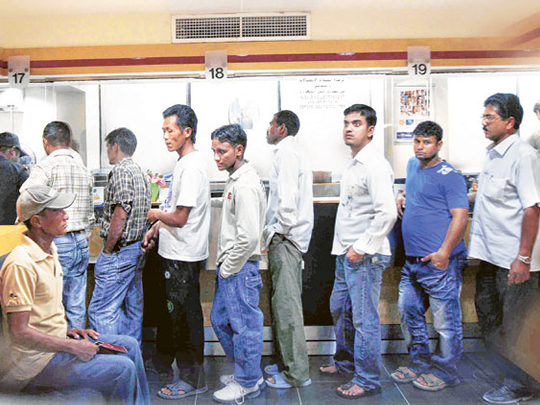
As more people leave home to work abroad every year, remittance volumes across the world are growing massively. This means good business for providers of money transfer services.
But while international money flows are growing at an excellent rate and more consumers are now banked, the largest share of the remittance market is still controlled by wire transfer organisations and exchange houses. Banks, which are supposed to be the purveyors of profit in the money markets, only hold a small portion of the remittance business.
Blue-collar workers, who represent between 65 and 70 per cent of Indians in the UAE, for example, send money from transfer providers to bank accounts in India. It is estimated that hawala makes up 20 to 25 per cent of the market. It would be interesting to note, however, that white-collar workers who have high-value remittance needs prefer the services of banks, considering that remittances to India, from one transfer operator to another, are capped at $2,500 (Dh9,180), according to MasterCard.
A January 2011 report by Ben Isaacson, vice-president of the Global Insights group of MasterCard Worldwide, said it's high time that banks "profitably" enter the remittance market. "Banks can capitalise on their strengths in global payments and harness new banking products and technology. This is true whether they decide to compete against (money transfer outfits) or partner with them on the sending side," Isaacson wrote.
"By leveraging internet service and distribution capabilities, the low-cost infrastructure afforded by reloadable prepaid cards and mobile technologies, as well as their access to superior foreign exchange rates, banks can gain share."
Real-time alerts
Pocket-friendly transfer fees, as well as convenience and service, are the primary reasons consumers prefer to send money through non-bank alternatives. Banks generally have limited operating hours, few locations outside large cities and staff who don't speak the consumers' language. They also collect higher fees, especially for low-value remittances, and require more time to process a transaction.
MasterCard's study shows that consumers sending money from the UAE to India and from Singapore to the Philippines, the two major remittance corridors in the world, prefer to transfer money quickly, inexpensively and safely, and they want a system that makes obtaining the funds easy for beneficiaries.
They are therefore more likely to favour a provider that can offer real-time alerts, such as an SMS, informing them that the transfer has gone through. "In this regard, banks' and their technology partners' reputations for reliability give them a big advantage," said Isaacson.
The banks' pricing schemes show that low-income workers end up spending more on fees and foreign exchange than what a white-collar worker would normally pay per transaction. "By moving consumers who do not require high-value services to online channels or alternative products, banks can reduce these discrepancies while maintaining exclusivity of the branch."
The UAE is home to over 100 money transfer organisations that vary in size, service and price schemes. The largest players, such as Western Union, tend to be the most reliable but MasterCard says they are also the most costly. While other providers offer competitive prices, they tend to have lower reliability and more limited options.








